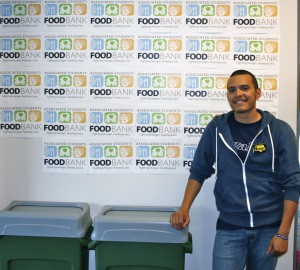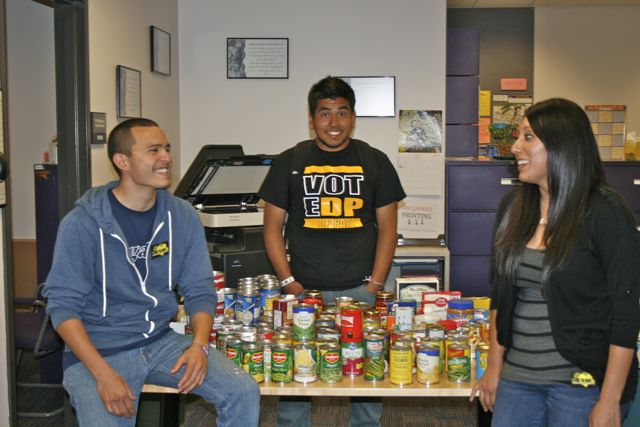Overview
Ever-increasing fees and the general state of the economy have resulted in a significant number of students skipping meals to make ends meet. The new A.S. Foodbank, which is now an official A.S. committee, is yet another instance where students identified a need in the student community and responded with the time, energy, and funding necessary to address that need.
After conducting a campus-wide survey that received nearly 2000 responses, student leaders and the Student Initiated Recruitment and Retention Commission took action. Modeled on recently established food banks at UCLA and UC Davis, strategically located collection stations were set up and a space found on the third floor of the UCen to house the Foodbank. Care was taken to afford student “customers” a measure of privacy while shopping.
 Currently the A.S Foodbank is accepting only non-perishable items, including canned goods, pasta, rice, and cereal. It also accepts toiletries like shampoo, toothpaste, mouthwash, lotions, and other essentials. There are two distributions per week, Tuesday and Wednesday from 7:30 a.m. to noon and 1 to 5 p.m. Initially staffed by volunteers A.S. hopes to eventually create two paid part-time student positions to handle inventory.
Currently the A.S Foodbank is accepting only non-perishable items, including canned goods, pasta, rice, and cereal. It also accepts toiletries like shampoo, toothpaste, mouthwash, lotions, and other essentials. There are two distributions per week, Tuesday and Wednesday from 7:30 a.m. to noon and 1 to 5 p.m. Initially staffed by volunteers A.S. hopes to eventually create two paid part-time student positions to handle inventory.
The A.S. Foodbank has definitely been utilized by students in need. A.S. President Paul Monge-Rodriguez expressed the hope that once A.S. has an efficient distribution system in place the university will allow A.S to distribute fresh produce, fruits, and dairy products, since the food bank is part of a larger A.S. goal to provide students with a range of healthy food alternatives.
Report from Special Project and Food Bank Advisor Tuyen Nguyen:
Overview based on demographic data collected from April 19th to May 18th.
The Associated Students Food Bank opened its doors on April 19, 2011 Although it was open for just a month during spring quarter, during that first month of operation it served 89 individuals. These individuals, picked up food a total of 139 times. This indicates that students came in multiple times during the month—some twice per week. Students shopped freely in the AS Food Bank with suggested limits for each food category then a staff member checked them out. Part of the process was the filling out of a questionnaire for planning purposes.
To meet the needs of students coming into the Food Bank, food and toiletries were donated by individual UCSB students, student organizations, faculty, staff, and campus organizations. Community members also contributed.
As the organizers became more targeted with therir outreach to specific departments, such as Family Student Housing, international students, nontraditional students, and specific support services departments, the flow of students served increased tremendously from 4 people per week during the first week to 55 people per week by May 27th.
Student organizers of the Food Bank initiated a donation campaign two weeks prior to the opening. Press releases, advertising literature, and university emails were distributed to UCSB, local media, and the Santa Barbara community. In addition to internet and paper advertisements, students addressed classes and organizations. They also walked door to door walk in Isla Vista to collect donations from students. The increased exposure resulted in more frequent pickups from collection sites, which are strategically placed around campus in locations including the AS Bike Shop, Davidson Library, Harold Frank Hall, the Student Resource Building, and the Associated Students/Multicultural Center Building. In particular, the Greek Life Office in the Student Resource Building, supplied more than 50% of the 5000 food and toiletry items donated.
Students were also able to secure in-kind and monetary contributions from the A.S. Office of the President, Student Initiated Recruitment and Retention Committee, UCSB Alumni Association, Graduate Student Association, A.S. Business Services Advisory Committee, and community groups. The funding helped purchase breakfast items, baby food, canned fruits, and other items that were in low supply. Fortunately, shopping trips have been infrequent as the Food Bank is currently overstocked with other items and more donations continue to flow in steadily. Additionally, students have partnered up with the Isla Vista GIVE project. GIVE is an annual move out drop off project and will donate its overflow for any additional needs.
Looking beyond spring quarter, we project that in the upcoming weeks we will have a flow of more students through the Food Bank due to increased advertising to the larger UCSB student body and personal referral from students who are currently utilizing the Food Bank.
Students are able to gauge who the Food Bank is serving and who to to target with outreach by analyzing the demographic data that have been collected in the survey students complete with their mandatory self declaration of income. In addition, testimonials by students have been useful to identify need among students who we did not realize needed our services, such as undergraduate students living in on-campus housing with meal plans.
Responding to requests and support from staff and students, the Food Bank will be open during Summer School sessions to provide additional resources to students in need.
We have attached the following documents of a more in-depth analysis of our impact on the University and individuals who we serviced so far in the 5 weeks we have open.
See also article in Student Affairs parent newsletter “Campus Connection”

